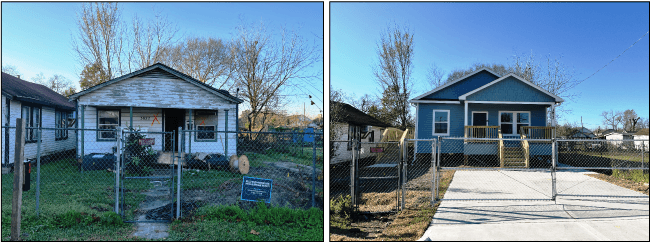Here’s a December 15, 2022 statement from the U.S. Government Accountability Office (GAO) concerning what they see as a necessary improvement in the process of disbursing Community Development Block Grant Disaster Recovery (CDBG-DR) funds.
We at REVITALIZATION agree with the GAO.
*****************
Hurricanes and wildfires affected millions of people in the U.S. and its territories in 2017 and 2018—and the U.S. government provided billions of dollars in grants to help with recovery efforts. But funding for housing activities—such as home repairs—has been slow to reach affected communities.
As of July 2022, states and territories that received the vast majority of the grants had disbursed only 28% of the funds.
The Department of Housing and Urban Development (HUD)—which administers the grants—doesn’t require grantees to collect and analyze data to identify and address delays in assisting survivors.
We recommended the agency do this, and more.
What GAO Found
As of July 2022, the seven states and territories receiving the vast majority of the 2017 and 2018 Community Development Block Grant Disaster Recovery (CDBG-DR) funds had disbursed 28 percent of the $11.9 billion they allocated for housing activities.
The grantees’ disbursements for housing activities funded with 2017 CDBG-DR funds ranged from approximately 4 percent to 51 percent.
The two grantees with the highest disbursement rates for 2017 funds (Texas and Florida) have more recent experience administering CDBG-DR funds.

Texas Homeowner Assistance Program Time Line and Process Steps. This time line is for Texas’s largest Homeowner Assistance Program. Because the phases’ durations are medians, their sum does not equal the total duration.
Texas expects to complete construction for its three Homeowner Assistance Programs by the end of 2023 or early 2024, and to serve about 7,900 homeowners.
Texas opened applications for its first and largest Homeowner Assistance Program about 1.3 years after Hurricane Harvey was declared a major disaster. Texas expects that it will take another 4.4 years from then until construction on homes is complete.
GAO’s analysis of available data as of August 2022 showed that the application processing and preconstruction phases of Texas’s Homeowner Assistance Programs each took longer than construction (see figure).
Factors that can significantly affect the length of the application process include the time households take to complete the application and provide required documentation, as well as the time Texas takes to conduct damage assessments and environmental reviews.
Data limitations prevented GAO’s analysis from pinpointing the duration of some individual process steps.
The Department of Housing and Urban Development (HUD) does not require Texas or other CDBG-DR grantees to collect accurate data on critical milestones.
Texas’s grant management system resets the date of key application processing milestones when an application has to repeat a step, which results in unreliable data for tracking those milestones.
This limits Texas’s ability to determine the true duration of individuals steps. Further, a HUD-funded 2019 study on the timeliness of CDBG-DR housing activities found that all but one grantee in the study faced challenges in developing a grant management system, which caused delays in program implementation.
By requiring grantees to collect and analyze timeliness data, HUD could better ensure that its grantees identify problem milestones and take corrective actions.
Why GAO Did This Study
Congress provided about $39 billion to HUD for CDBG-DR and mitigation grants to help communities recover from the 2017 and 2018 hurricanes and wildfires.
Seven grantees—California, Florida, North Carolina, Puerto Rico, South Carolina, Texas, and the U.S. Virgin Islands—received over 90 percent of the funds. They generally budgeted more than 50 percent of the CDBG-DR funds to address unmet housing needs.
The Additional Supplemental Appropriations for Disaster Relief Act of 2019 includes a provision for GAO to audit issues related to the 2018 presidentially declared major disasters.
This report examines, among other things, (1) the status of the seven grantees’ 2017 and 2018 CDBG-DR housing activities, (2) Texas’s implementation of its Homeowner Assistance Programs, and (3) the extent to which HUD requires grantees to collect data to manage programs effectively.
GAO analyzed data from HUD and the Texas grantee. GAO also reviewed documentation and interviewed officials from HUD and Texas. GAO focused on Texas in part because it had expended the most funds and plans to focus on other grantees in future work.
RECOMMENDATIONS
GAO is making two recommendations to HUD, including that it require CDBG-DR grantees to collect and analyze data needed to monitor the timeliness of their housing activities and inform corrective actions. HUD agreed with one recommendation and neither agreed nor disagreed with the other, as discussed further in the report.
Here are two recommendations GAO made to the Department of Housing and Urban Development:
- The Assistant Secretary for Community Planning and Development should revise HUD’s standard Quarterly Performance Report format and related guidance to ensure the reports provide clearer and more transparent information on the status of grantees’ CDBG-DR activities. For example, the revised report format could include a summary of aggregated performance measures at the activity level. When we confirm what actions the agency has taken in response to this recommendation, we will provide updated information.
- The Assistant Secretary for Community Planning and Development should, in the event of future CDBG-DR funding, require recipients to collect and analyze data on critical milestones needed to monitor the timeliness of their housing activities and inform corrective actions, consistent with leading project management practices. When we confirm what actions the agency has taken in response to this recommendation, we will provide updated information.
Featured before-and-after photos courtesy of Texas General Land Office.

